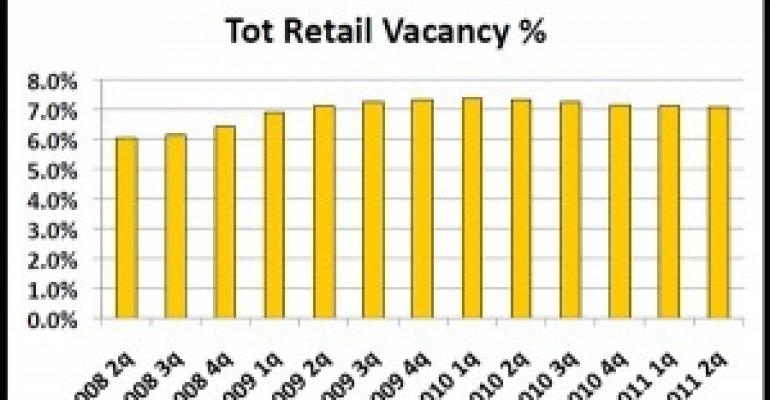With the second quarter in the books, early indications are that the retail sector continued its recovery.
CoStar's first look report said that the retail real estate market has now experienced eight straight quarters of positive net absorption resulting in a cumulative 99 million square feet absorption.
The overall vacancy rate remained steady at 7.1 percent.
Click for larger image.
National Highlights
- Second quarter net absorption increased to 11.1M square feet, 700,000 square feet more than the previous quarter's net absorption of 10.4 square feet. This, however, remains well below the robust fourth quarter net absorption rate of more than 26.5M square feet. The two year average net absorption rate is 12.4M square feet.
- The national retail vacancy rate remained steady at 7.1% in large part due to a 40-year record
low amount of new retail square footage completed, 7.4M square feet
- New retail deliveries will be minimal for the foreseeable future as retail space under construction
in the second quarter totaled 26.8M square feet. This compares to more than 145M square feet
of retail space under construction in the second quarter of 2008.
- The national retail rental rate declined to $14.74 per square foot from $14.84 per square foot in
the first quarter. While record low new supply has stabilized the retail vacancy rate rental rates
won't increase until retail demand increases which would require significant increases in hiring
and wage growth.
Click for larger image.
Property Type Highlights
- Lifestyle centers continued to suffer the largest rental rate declines with second quarter rental
rates declining $.94 from the first quarter rental rate.
- Lifestyle centers also suffered the largest quarterly increase in vacancy rate increase from 8.6%
in the first quarter to 8.9% in the second quarter.
- Due to the continued weak performance of Lifestyle centers the spread in rental rates between
Lifestyle centers and malls has declined from more than a 56% rental rate premium for Lifestyle
centers in the first quarter of 2008 to less than a 30% premium today. This is due largely to two
factors. First, aggressive building of lifestyle centers during the last decade continues to haunt
Lifestyle centers as they are forced to trade occupancy for reduced retailer quality and reduced
rents. Conversely, malls significantly reduced their rate of new construction in the last
decade building less than 40% of the mall square footage built in the 1970's.



